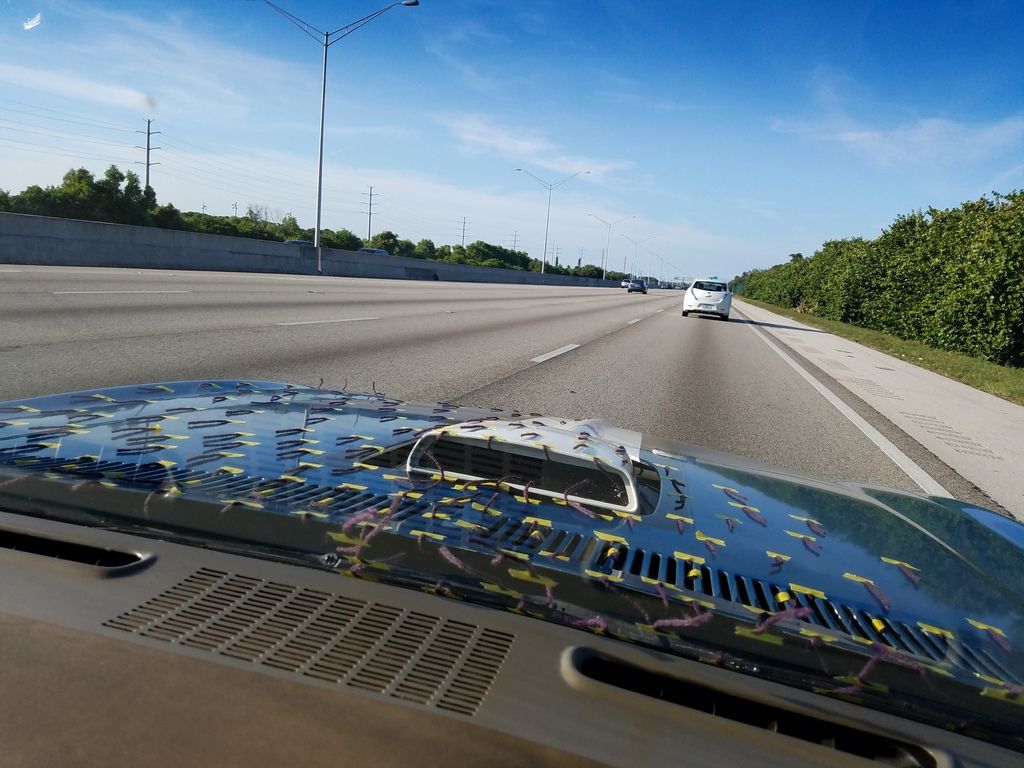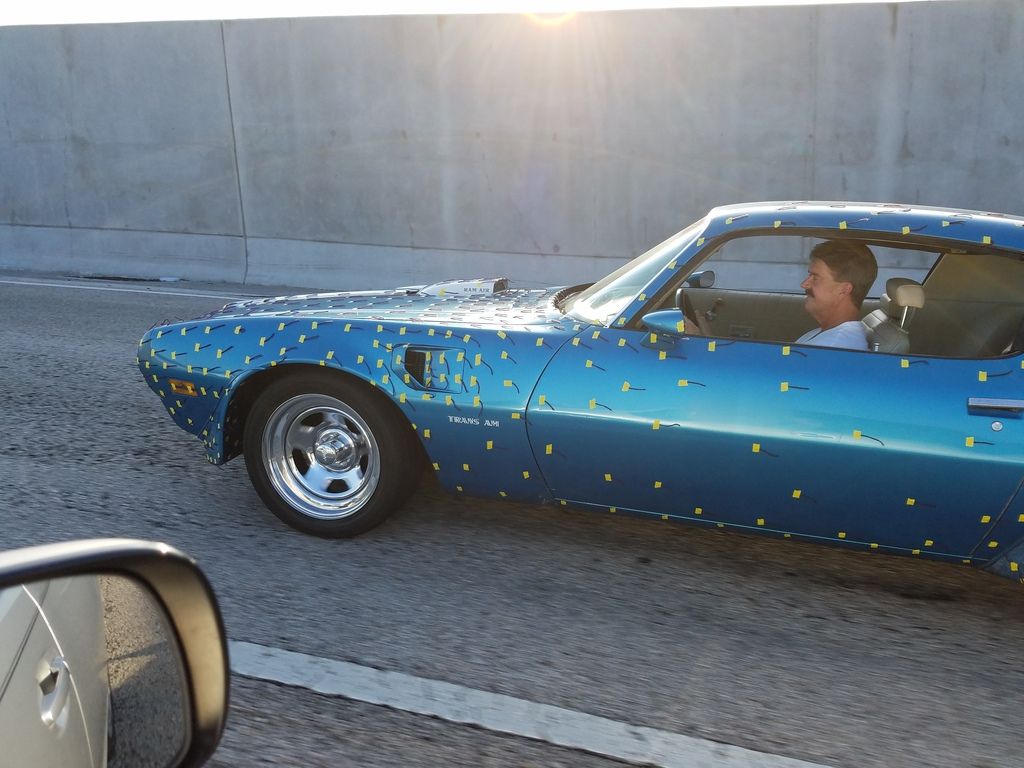In reply to Gimp (Forum Supporter) :
Looks rather menacing.

While the rear center of the hood is sealed to the intake track is the rest of the rear edge of the hood sealed to the cowl?
I did tuft testing at highway speeds with a 2nd gen firebird which is probably close enough to the Camaro to use for general observations. I used a customers car (with permission) because the body is exactly like my Firebird aero project and would give me a baseline to look at. The high pressure area at the base of the windshield doesn't extend very far forward at all. The Trans Am guys were rather disappointed when my testing showed the shaker scoop gets no "Ram Air" benefit although it does allow ambient temp air in for combustion because of the bullet effect. Also, note in the pic below the tufts at the leading edge of the hood are pointing up.
[URL=https://app.photobucket.com/u/NOTATA/a/1cb4d474-09b3-46be-98b3-14fc870256eb/p/61c4020d-7072-4396-817a-b5c524f96558] [/URL]
[/URL]
I'm curious how the extra large front fender flares affect the function of the fender vents on the Camaro. Have you considered opening up the fender vents?
[URL=https://app.photobucket.com/u/NOTATA/a/1cb4d474-09b3-46be-98b3-14fc870256eb/p/bfdcbd6d-316b-4358-baeb-47447d74c8ad] [/URL]
[/URL]
In reply to NOT A TA :
"While the rear center of the hood is sealed to the intake track is the rest of the rear edge of the hood sealed to the cowl?"
It's a great question and something I never considered. Currently it is not, but I will absolutely be able to take care of that easily.
That's also super revealing information about the high-pressure area on the hood.
As far as the vents go, as I read it, I have to use factory pieces. There are a difference of vents from a slightly different year that are louvered and may have more open area. Could be worth playing around with.
Excellent points all around. I love this bar.
If you look at the 88-89 era Firebird GTA models you'll see where the factory installed vents are at the rear sides of the hood. They're in roughly the same area as the #5 is on the plan view pic of a Miata hood Keith posted.
In reply to NOT A TA :
Speaking of factory installed vents, Datsun put the 280Z hood vents (one on each side of the hood) about 15" from the base of the windshield as described earlier.
I've never liked using tufts, have to set up a camera to really know what's going on. I started using flow-vis a couple years ago, swear by the stuff now...no cameras, paint on and have a look!
Along with what buffalo said...
Those louvers you got, especially when the fins are angled steeply, create a pretty large drag area behind them (top-down rotation) that could either hurt the cowl intake pressure zone, or help it -largely depending on where it's placed.
you could take a look at the viper imsa car - there could be a decent gain to be had by ducting the hood where it wants to be (based on the top/bottom pressure differential), and making a duct to your intake ahead of the ducts.
Hood extractor design and location are critical to functionality. The ones you have are not very functional at all. I suggest you take a look here: https://racelouvers.com/content/Race-Louvers-Hood-Vent-Tech-Tips.pdf
In reply to 302roadracer :
Maybe I'm missing something here, but most of what's in there makes it seem like what we have all laid out here is fine. Especially in terms of vent angle and even the cowl induction issues (although they do talk about spreading the center vents apart by 6 inches).
Am I missing something? If there is something specific to look at in there, feel free to point it out.
For what it's worth...My hood is forward hinged and because if I use the stock sized 3" air filter, I can't latch the hood and it sticks open about 3/4" at the base of the windshield while it's sitting on top of the two open position latches. It will latch if I use a 2.5" filter but I don't know if that is too restrictive. Anyway, during a top speed highway run, the hood lifted at least 6" to the point that it was hard to see out of the windshield. I think that I will put 2" latch extensions on to keep the hood rear end open that 2" and still be latched with some small flaps on the sides. A rear hinged hood could also be modified to do the same thing with spacers on top of the hing.
That's pretty nice. ![]() I just discovered you build post and am on page 10 so far. It's a great build thread, but will take me a while to catch up. Hopefully not as long as it took you to build.
I just discovered you build post and am on page 10 so far. It's a great build thread, but will take me a while to catch up. Hopefully not as long as it took you to build.
GIMP: Would like to hear what your results are. Do you have any information on what those underwood temperatures were before the installation of your vents?
I tend to keep my eye on hood vent ideas from those who have spent some money and wind tunnel time in the development of race cars. Specifically the C5R and C6R Corvette race cars. BMW, Lexus, and Ferrari have also spent a lot of time on their GTLM and GTD cars developing hood and fender vents that prove to be interesting observations.
A single lip on the front side of a vent, (aka the GT40's of '66 thru '69), to create a low pressure area just behind the lip to draw the heat out;- seems make the most sense to me.
In reply to RACINGNUT :
Unfortunatly, no data with underhood temps other than intake logs. So, not scientific, but at least I look cool?
As far a gurney flaps on the leading edge of the louvers, I've seen a lot of people caution about doing that without any real data, as it doesn't always work out in a positive way.
Gimp (Forum Supporter) said:In reply to RACINGNUT :
Unfortunatly, no data with underhood temps other than intake logs. So, not scientific, but at least I look cool?
As far a gurney flaps on the leading edge of the louvers, I've seen a lot of people caution about doing that without any real data, as it doesn't always work out in a positive way.
IIRC in one of AJ Hartman's recent wind tunnel tests on youtube he found the gurney flap in front of the hood vents did increase airflow through his fully ducted radiator however it caused the exiting air to be thrown up higher and it caused a reduction in down force because of how it affected the rear wing.
You'll need to log in to post.